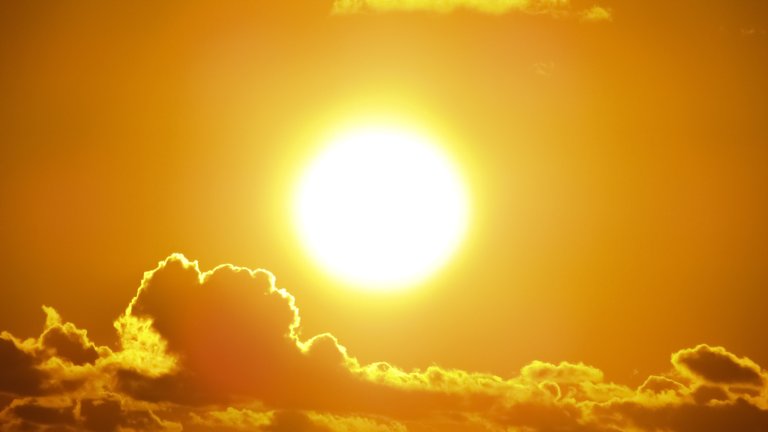
Taking a quick glance at the Hertzsprung-Russel diagram might give one the idea that stars are a complicated existence. The problem takes form when you consider the presence of age. Different Stellar lifespans and ages combined with the fact that they progressively lose mass over the course of their lives brings about much confusion and what appear to be inconsistencies. Say for instance the likes of Eta Carinae vs. The Pistol Star, Similar mass, similar size, logically one might jump to the conclusion that they have similar surface temperatures then. However in reality Eta Carinae burns at a blinding 40,000 degrees kelvin, while the Pistol star yields a still very hot, but comparatively weaker 11,500 degree surface.
How can this be? They have the same mass and size, so the energy produced in their cores should be the same, and get deluded the same. Logically they should be equally hot, and thus equally luminous, but in reality, while they are both cataclysmic-ally bright stars, one eclipses the other with ease.
As it turns out, age is the major factor going on here. They may hold similar masses now, but from the start of its life Eta Carinae likely had far more mass then the pistol star ever did. And now that it is older, it's actively burning Carbon with other elements to create Oxygen, Neon, and mostly Magnesium. While the Pistol Star remains in the process of burning Helium in the triple-alpha process, creating Carbon. The Pistol Star will catch up one day, but it is currently younger proportionately speaking to its total lifespan.
(Photo of the nebula surrounding the remarkably unstable Eta Carinae, the glare in the middle represents the visible luminosity of 90,000 Suns)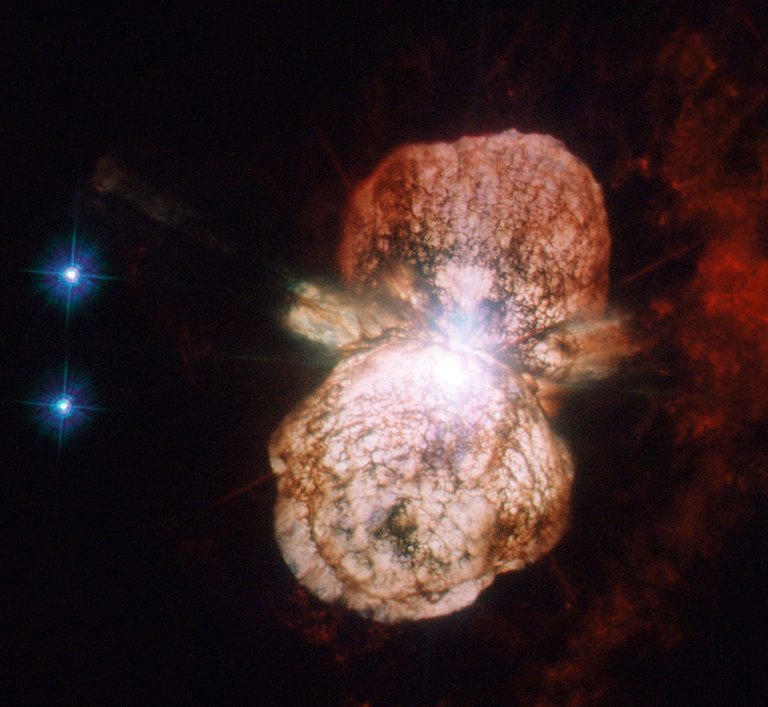
But these high mass Hypergiants are for later articles, for now, let's scale things down to a more familiar kind of star.
Low mass stars, High mass stars, these are the primary groupings that which are considered when looking into stellar physics. The difference? High mass stars are capable of fusing elements in their cores all the way up to the atomic mass of Iron. Low mass stars are only capable of fusing Hydrogen into Helium, and a tad bit of Helium into Carbon. Simply because their cores don't posses the heat and pressure requirements that are needed for fusion to continue with more demanding elements. This makes high mass stars much more interesting, however we'll hold off on them for the time being, and focus on their more stable, longer-living brethren.
What defines a star as being of, "Low Mass"? Clearly all stars posses tremendous mass counts by comparison to planets of any kind, but compared to each other, some stellar bodies are simply formed with less starting material attained when they were proto-stars.
For a star to fit the low mass category, it is likely born with a mass equal to something less than 8 solar masses, (1 Solar Mass, SM, is the equal to the current mass of the sun). However while this group of stars is commonly held apart from the higher mass stars, they can be divided into many groups of their own. Let's start with the feather weights, the smallest of the stars, and ironically also the densest. Red Dwarfs.
(Proxima Centuri, imaged above, is a red dwarf and also the closest star to our sun, at 4.3 light-years)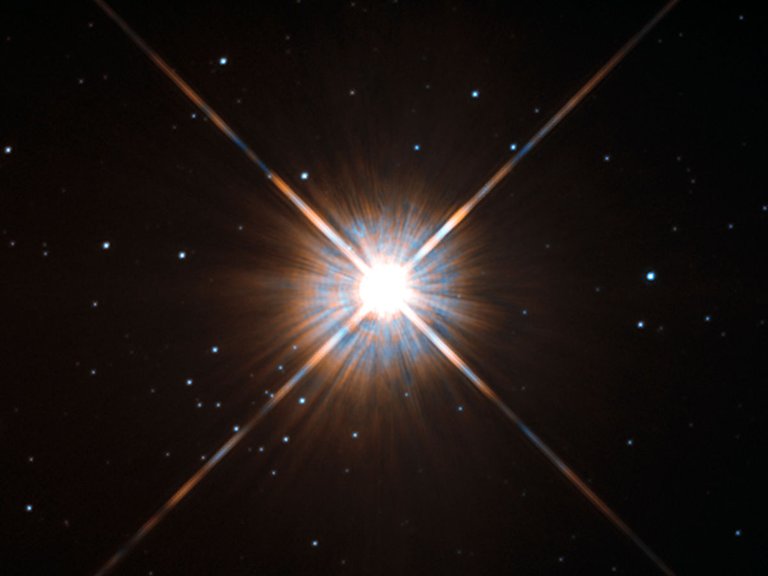
Red dwarfs, for as unknown to our eyes as they are, stand as the most abundant stars in the Universe. It is estimated as many as 3/4 of all the stars in the universe are red dwarf stars. Yet, we cannot see any of them.
Stellar luminosity is dependent on two things, surface temperature, and size. Red dwarfs are rather tiny for star standards, the smallest ones usually have the radius of the planet Jupiter, and the largest can only span around 1/5 the suns diameter. They are easily the smallest stars in the universe.
Then there is the factor of surface temperature. Stellar temperature can be concluded based on the spectra of the surface, meaning it's color. The coolest stars, with surfaces just above 3000 degree's kelvin(K), are deep red. As you get hotter they will shift to orange (4500 K), from orange into yellow (5500 K, like the sun), then into white (6500 K), from white to light blue (Minimum of 8000 K to be considered blue), and then past that they just become a deeper and deeper blue.
So as the name suggest, red dwarfs are of the cool variety. Their surfaces rarely exceed 4000 K, rendering them not only very small, but very cool. And with this combination, you get very dim stars that cannot be seen with the naked eye at an excess of half a light-year.
But for as boring as they may sound, red dwarfs are actually rather unique by comparison to the other kinds of stars.
For one, red dwarfs are fully convective, this means that from the core to the surface, gas is freely flowing and capable of rising to the surface from heat, then cooling and falling back to the core. They are the only stars capable of this because of how low the pressure in their core's are. In fact, this is the main way that heat is transferred to their surfaces, rather than by photons.
This is for two reasons, one is that they don't generate much energy in their core's, two is that they are incredibly dense making it hard for radiation to get through. An average red dwarf has a density of around 56,000 Kg per Cubic Meter. To give some perspective on this, the density of Osmium, the densest natural element, is 22,000 Kg per Cubic Meter. Red dwarfs are barely even considered a plasma gas, they are almost seen as liquid plasma, a very very dense liquid plasma at that. Which is even crazier when you remember they are comprised almost entirely of hydrogen and helium, two of the lightest elements, meaning those atoms have to be very close together.
Red dwarfs also carry another interesting trait. As stars go up in mass, their lifespans ironically shorten. This is because increased mass, while it does mean increased fuel, causes them to burn the fuel faster. Red dwarfs have on average 0.1 solar masses, some can have much less. This means they can live for very long periods of time. In fact, the red dwarfs formed at the birth of the universe are still around today, and with continue to live for far, far longer. The average red dwarf has a predicted lifespan of around 10 trillion years.
Imagine that, the sun will live for around 10 billion years, the universe is only around 13.7 billion years old. These stars are barely even cutting into their lifespans now.
Once they've used up every ounce of their hydrogen, the eventual fate of the red dwarf is not entirely known, it's believed they might expand like the rest of the low mass stars, however it is hard to say because they don't fuse heavier elements, meaning they are likely to lack the core energy required to cause expansion.
Red dwarfs stand apart from the remainder of stars for a variety of reasons, but they never reach the point in which a star can create Iron, so they fall under the same category as the remainder of Low Mass Stars.
Next we'll move up the scale to more heavy stars, ones that find similarities with our own sun. Truth be told, there isn't any fundamental difference between a star that begins with 1 Solar Mass and one that starts with just under 8. The more massive star will certainly be more luminous, it will grow to larger sizes as it ages and it's surface temperature will reach the point of being a blue dwarf, even with as little as 1.8 solar masses from the start a star will likely be blue during the main sequence of hydrogen burning. However while the traits can vary, the stellar evolution and means of demise are constant with any stars between 0.4 (Maximum mass for a red dwarf), and 8 solar masses.
(In spite of being both larger and hotter than the sun, Regulus only possesses just under 4 Solar Masses)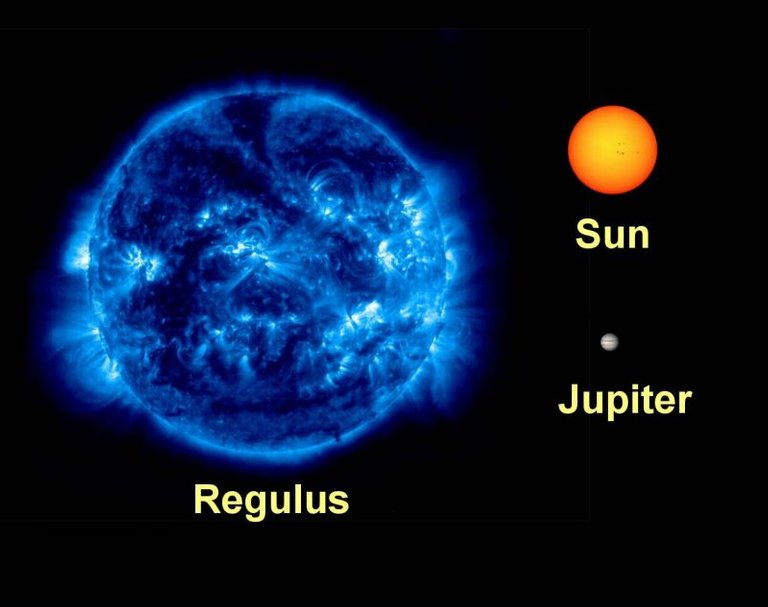
This consistency is nice because it means we can explain their structure and functions all in one, without having to discuss every kind of star from the Sun to Regulus.
Unlike red dwarfs, any star that isn't, well, a red dwarf, is not fully convective. Convection currents do still happen, but they don't reach into the core, only in the photo sphere. This means that any elements in the core will remain there. And all of the heat and energy brought to the surface is done so by means of radiation.
Again, the more massive, the more energy, as the components of the core are being fused at a higher rate. However higher mass fusion will create more heat, which in turn can cause a star to expand. And this is what almost all of these stars do.
Whether they are a yellow dwarf, like the sun, or more blue, they all inevitably will end up appearing redder and bigger later in life. How big these stars get is dependent on their starting masses.
Actually let me stop here for a moment, you may have noticed that I've been using the term, "Starting Mass" a lot. What do I mean by this? Stars don't have constant mass, they lose it throughout their lives due to stellar winds, they perpetually are blasting outermost materials into deep space. In fact, this relates to the whole, 'age causes confusion' aspect. For instance, I stated that the initial mass of a star must exceed 8 Solar masses to be considered out of the Low mass category. However, Stars with just over this are likely to have just over 5 solar masses by the time they are ready to die. So something like Betelgeuse, a star with around 7.7 solar masses, is still a high mass star that will die in the same way as high mass stars and create iron, it is just near the end of it's life and has lost much mass since the beginning.
Anyway, back to the stellar cycle. As these stars age, they burn away the hydrogen in their cores, when they do, they don't just die such as Red dwarfs, which are incapable of burning anything heavier than Hydrogen. Instead they go on the fuse Helium into carbon, Oxygen, and some Neon.
More massive stars in this group will create a higher abundance of these materials, in fact, it is likely our sun won't be able to make any Neon at all, but it will fuse helium into Carbon, and fuse Carbon with another helium to make Oxygen.
When these stars move on to higher mass atomic fusion, an interesting thing happens, for a moment, the stellar equilibrium is compromised. This is the equal opposing force balance between Gravity, pulling the star inward, and the force of expansion from fusion pushing it outwards.
The fusion of heavier elements overwhelms the gravity and causes the stars to puff up. And even though more energy is being created in the core, the surface actually cools as the surface area increases so much, there's more star to heat. Every star within this category turns red at some point or another, at their biggest, they can be 100 times their original diameter.
Even though the star has a cooler temperature, the increase in size actually makes the star's total luminosity higher, by quite a bit in some cases. Take Arcturus and the sun for example. Our sun is still fusing hydrogen, but the star Arcturus has moved on to Helium fusion. What makes Arcturus an interesting star to study is that it has around 1 Solar mass, meaning it's life will be very similar to that of our sun, watching it is like watching the future of our own caretaker star. Arcturus is in it's red giant phase, due to expand even more as time goes on, it's current luminosity exceeds the sun's by 170 fold.
As the stars puff up, the stellar winds become stronger, they blow off mass at a much faster rate, and in one big swath, blast away nearly a third of their mass in the form of now free nebulous gas. The sudden loss of mass actually causes the star to slow it's fusion, allowing the core to cool a bit and thus the star shrinks down to an orange giant, a bit hotter surface, but smaller by a factor of 10. The compression from shrinking actually then heats the core back up, and the star gets right back expanding. It does so again and this time the same thing happens, as before, more mass gets blown off and the star shrinks once again only to repeat the cycle.
They typically will do this a good 8-12 times before eventually, nothing remains of the stars outer layers, all of it has flown away. And bear in mind, all of this expanding and contracting happens on average for 1/10 the star's total life, most of the time they just happily burn Hydrogen.
Now the inner layers have been perpetually squeezed over and over by this point, which presses the carbon and oxygen molecules that make up the core closer and closer. They actually get so astonishingly close to each other, the remaining core become one of the densest objects known, a white dwarf.
White dwarfs, as well as the remnants of the stars outer layers will get an entirely separate spotlight soon, as there's enough material to work with when talking about them that this article would go on for about a thousand more words if they were included.
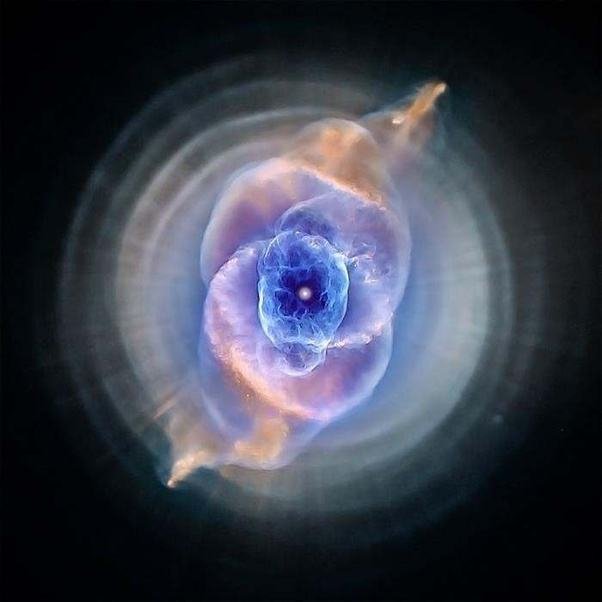
As for now, I'll leave things as they are known, I plan on creating more entries about stars within the very near future, perhaps working up the scale, first talking about the stellar remnants of low mass stars next, moving on to high mass stars and their more exiting means of destruction. And I promise you, by the end you'll be quite glad to know our sun is a gentle, stable long living cosmic nuclear power plant rather than one of its more restless Siblings.
By the way, hit Ctrl+F and type, "star".
Image Origins:
https://www.pexels.com/search/sun/
https://www.nasa.gov/mission_pages/hubble/science/eta-carinae.html
https://en.wikipedia.org/wiki/Proxima_Centauri
http://earthsky.org/brightest-stars/best-regulus-the-heart-of-the-lion
http://earthsky.org/brightest-stars/best-regulus-the-heart-of-the-lionhttps://www.quora.com/What-is-the-difference-between-planetary-nebulae-and-supernovas
This post is very informative for me.thaks man
Hey -- . ... ..... ....... ......... hello?
Who's there?